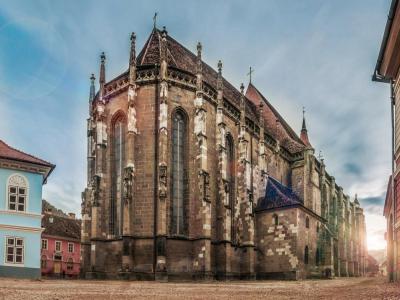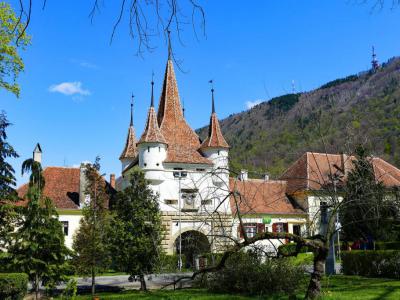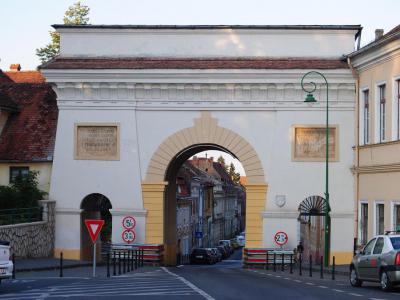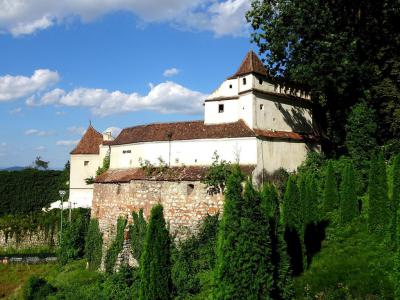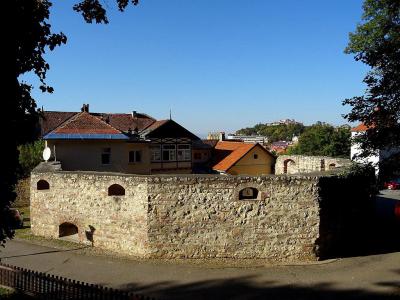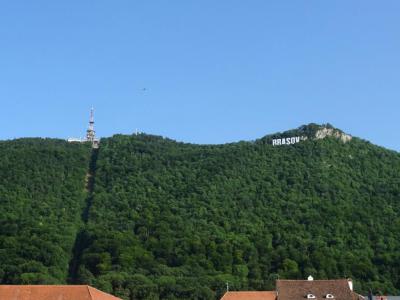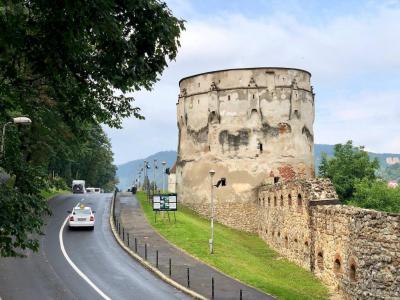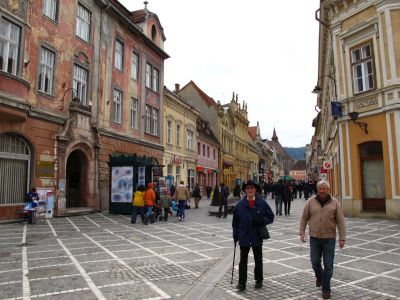Brasov Introduction Walking Tour (Self Guided), Brasov
Brasov is a city in the historical Romanian region of Transylvania. It is surrounded by the Southern Carpathians including Mount Tampa, which overlooks Brasov.
The city was first called Corona from the Latin word for "Crown." This name was first mentioned in 1235 AD. It is thought to have been named Corona for the reference St. Catherine's Monastery. It was then renamed to Brasov, after the river Barsa. For a brief period from 1950 to 1960, Brasov was named Stalin City.
Brasov was historically an important commercial trading hub between Austria and Ottoman Empire. The city was part of Hungary from its earliest days through 1570 when it was ruled by the Principality of Transylvania. It then came under control of Austria and Austria-Hungary from 1804 to 1918 when it was turned over to Romania.
The city is known for manufacturing industrial equipment, airplanes and textiles. Brasov is also home to Ursus Brewery. It was established in 1892 as a small brewery. Today, it is the largest beer producer in Romania.
In 1583, the first school of Romanian language was established in Brasov. Visitors can learn a great deal about this part of its history at the Museum of the First Romanian School.
Brasov has retained much of its medieval charm so today the city is a growing tourist destination. Visitors can see the ruins of the walled city and the bastions as well as historical buildings like the Black Church and the numerous charming historical houses surrounding Council Square.
Those who want to have a bird's eye view of all of Brasov can take a cable car to Tampa Mountain where they will also see ruins of historical structures.
Follow this self-guided walking tour to see the historical beauty of Brasov, Romania.
The city was first called Corona from the Latin word for "Crown." This name was first mentioned in 1235 AD. It is thought to have been named Corona for the reference St. Catherine's Monastery. It was then renamed to Brasov, after the river Barsa. For a brief period from 1950 to 1960, Brasov was named Stalin City.
Brasov was historically an important commercial trading hub between Austria and Ottoman Empire. The city was part of Hungary from its earliest days through 1570 when it was ruled by the Principality of Transylvania. It then came under control of Austria and Austria-Hungary from 1804 to 1918 when it was turned over to Romania.
The city is known for manufacturing industrial equipment, airplanes and textiles. Brasov is also home to Ursus Brewery. It was established in 1892 as a small brewery. Today, it is the largest beer producer in Romania.
In 1583, the first school of Romanian language was established in Brasov. Visitors can learn a great deal about this part of its history at the Museum of the First Romanian School.
Brasov has retained much of its medieval charm so today the city is a growing tourist destination. Visitors can see the ruins of the walled city and the bastions as well as historical buildings like the Black Church and the numerous charming historical houses surrounding Council Square.
Those who want to have a bird's eye view of all of Brasov can take a cable car to Tampa Mountain where they will also see ruins of historical structures.
Follow this self-guided walking tour to see the historical beauty of Brasov, Romania.
How it works: Download the app "GPSmyCity: Walks in 1K+ Cities" from Apple App Store or Google Play Store to your mobile phone or tablet. The app turns your mobile device into a personal tour guide and its built-in GPS navigation functions guide you from one tour stop to next. The app works offline, so no data plan is needed when traveling abroad.
Brasov Introduction Walking Tour Map
Guide Name: Brasov Introduction Walking Tour
Guide Location: Romania » Brasov (See other walking tours in Brasov)
Guide Type: Self-guided Walking Tour (Sightseeing)
# of Attractions: 9
Tour Duration: 2 Hour(s)
Travel Distance: 3.0 Km or 1.9 Miles
Author: ellen
Sight(s) Featured in This Guide:
Guide Location: Romania » Brasov (See other walking tours in Brasov)
Guide Type: Self-guided Walking Tour (Sightseeing)
# of Attractions: 9
Tour Duration: 2 Hour(s)
Travel Distance: 3.0 Km or 1.9 Miles
Author: ellen
Sight(s) Featured in This Guide:
- Council Square (Piața Sfatului)
- Black Church (Biserica Neagra)
- Catherine's Gate (Poarta Ecaterinei)
- Scaffold's Gate (Poarta Schei)
- Weavers' Bastion (Bastionul Tesatorilor)
- Spinners' Bastion (Bastionul Funarilor)
- Tampa Cable Car and Tampa Mountain
- Drapers' Bastion (Bastionul Postavarilor) and Furriers’ Bastion (Bastionul Cojocarilor)
- Republicii Street
1) Council Square (Piața Sfatului) (must see)
The Council Square (Piața Sfatului) is a must-see location in the historical center of Brasov. The Square has been used as a marketplace since 1364, being visited by merchants from the country and abroad.
A pillory once stood in the middle of the square. It was used for punishing those who were thought to be criminals or practitioners of witchcraft. Some were publicly humiliated, while others were beheaded.
The Council Square is surrounded by houses that date to the 18th century. Many of these homes have been declared historical monuments. The most important building in the square is the Council House (Casa Sfatului), which was built in 1420. Located in the middle of Council Square, the building is now the Brasov County Museum of History.
The Black Church (Biserica Neagra) is another building that tourists will see. This church is a must-see site on its own, deserving a full tour thanks to its beautiful architecture and rich history. Another religious edifice located along the square is the Council Square Orthodox Church, a 19th-century, neo-Byzantine church dedicated to the Dormition of the Mother of God.
Muresenilor House Memorial Museum (Muzeul Casa Muresenilor) and the Hirscher House are interesting stops along the square. The Museum of Urban Civilization is worth a visit as well. This museum is housed in a 16th-century building with a reconstructed Renaissance facade. The museum focuses on the building itself and the former owners of the house along with paintings and artifacts from Transylvania's past.
Other attractions near Council Square include the White Tower, Rope Street, Republicii Street, the Black Tower, and many others.
A pillory once stood in the middle of the square. It was used for punishing those who were thought to be criminals or practitioners of witchcraft. Some were publicly humiliated, while others were beheaded.
The Council Square is surrounded by houses that date to the 18th century. Many of these homes have been declared historical monuments. The most important building in the square is the Council House (Casa Sfatului), which was built in 1420. Located in the middle of Council Square, the building is now the Brasov County Museum of History.
The Black Church (Biserica Neagra) is another building that tourists will see. This church is a must-see site on its own, deserving a full tour thanks to its beautiful architecture and rich history. Another religious edifice located along the square is the Council Square Orthodox Church, a 19th-century, neo-Byzantine church dedicated to the Dormition of the Mother of God.
Muresenilor House Memorial Museum (Muzeul Casa Muresenilor) and the Hirscher House are interesting stops along the square. The Museum of Urban Civilization is worth a visit as well. This museum is housed in a 16th-century building with a reconstructed Renaissance facade. The museum focuses on the building itself and the former owners of the house along with paintings and artifacts from Transylvania's past.
Other attractions near Council Square include the White Tower, Rope Street, Republicii Street, the Black Tower, and many others.
2) Black Church (Biserica Neagra) (must see)
The Black Church (Biserica Neagra) in Brasov, is one of the most beautiful Gothic monuments in Romania and the second-largest church in the country. Built from 1383 to 1477, over 600 years old, the Black Church is the city’s symbol. The stone church is the parish church of the Evangelical Lutheran community. Its name is derived from the church's walls, which turned black during a fire in 1689.
The church was built on the site of a Romanesque church, destroyed in 1241. It was originally a Roman-Catholic church dedicated to Saint Mary, the patron saint of Brasov, reflected in a fresco in the southern hall. The Protestant Reformation changed the church from Roman-Catholic to Evangelical-Lutheran in 1542.
Though the church was designed in the Gothic style, reconstruction works over the years were carried out in the Baroque architectural style. These reconstruction efforts were necessary to keep up with the growing size of parishioners and damage to the church caused by fire and earthquakes.
The Black Church has the biggest mechanical organ in the country. The Baroque organ, erected in 1839, has almost 4,000 pipes. It is one of the few Baroque organs in the world that remains in use and unchanged from its original form. The church is also known for its six-ton bronze bell, the third-largest bell in Romania.
The second-largest collection of oriental carpets in Europe is located inside the Black Church. There are 110 carpets on display, dating from the 15th century. There are no written records regarding where or when the carpets were received, but an inventory shows only 39 rugs in the church in the 1830s. It is thought that many of the rugs were bequeathed to the church after the deaths of parishioners.
Visiting the Black Church, the main city landmark, is one of the best things to do in Brasov. Its history is a faithful image of the main events that created the past of Transilvania in times of peace and war.
The church was built on the site of a Romanesque church, destroyed in 1241. It was originally a Roman-Catholic church dedicated to Saint Mary, the patron saint of Brasov, reflected in a fresco in the southern hall. The Protestant Reformation changed the church from Roman-Catholic to Evangelical-Lutheran in 1542.
Though the church was designed in the Gothic style, reconstruction works over the years were carried out in the Baroque architectural style. These reconstruction efforts were necessary to keep up with the growing size of parishioners and damage to the church caused by fire and earthquakes.
The Black Church has the biggest mechanical organ in the country. The Baroque organ, erected in 1839, has almost 4,000 pipes. It is one of the few Baroque organs in the world that remains in use and unchanged from its original form. The church is also known for its six-ton bronze bell, the third-largest bell in Romania.
The second-largest collection of oriental carpets in Europe is located inside the Black Church. There are 110 carpets on display, dating from the 15th century. There are no written records regarding where or when the carpets were received, but an inventory shows only 39 rugs in the church in the 1830s. It is thought that many of the rugs were bequeathed to the church after the deaths of parishioners.
Visiting the Black Church, the main city landmark, is one of the best things to do in Brasov. Its history is a faithful image of the main events that created the past of Transilvania in times of peace and war.
3) Catherine's Gate (Poarta Ecaterinei) (must see)
Catherine's Gate (Poarta Ecaterinei) stands as a significant historical monument built in 1559 by the Tailors' Guild. This gate was constructed to replace an earlier one that succumbed to flooding in 1526. It is noteworthy as the only remaining original city gate from medieval Brasov, with its significance further highlighted by its connection to the former Saint Catherine's Monastery, after which it is named.
The gate's architectural design includes a central tower, which is the main surviving part of the original structure. Historical records reveal that there was also a wooden extension, demolished in 1827, with a detailed model of this original structure displayed at the Weaver's Bastion museum, showcasing Brasov circa 1600.
During the Saxon governance from the 13th to the 17th century, the gate also served a socio-economic function. It was known as Porta Valacce, or the Vallah's Gate, and was the only entry point for Romanians living outside the fortress in the neighborhood of Schei. These Romanians, restricted from owning property within the fortress walls, were allowed entry only at designated times and were required to pay tolls for selling their goods inside the citadel.
Symbolically, the gate features four small corner turrets, a common motif in Transylvanian towns, denoting the city's judicial autonomy and the "right of the sword" (ius gladii)-the authority to impose capital punishment. Above the entrance, the tower proudly displays Brasov’s coat of arms, depicting a crown on an oak trunk with roots, symbolizing strength and resilience.
Today, Catherine's Gate functions as a museum, offering visitors a glimpse into its rich history and the broader heritage of Brasov. This gate not only serves as a physical reminder of the past but also as a cultural and educational landmark, illustrating the complex historical interactions between different ethnic groups in Transylvania.
The gate's architectural design includes a central tower, which is the main surviving part of the original structure. Historical records reveal that there was also a wooden extension, demolished in 1827, with a detailed model of this original structure displayed at the Weaver's Bastion museum, showcasing Brasov circa 1600.
During the Saxon governance from the 13th to the 17th century, the gate also served a socio-economic function. It was known as Porta Valacce, or the Vallah's Gate, and was the only entry point for Romanians living outside the fortress in the neighborhood of Schei. These Romanians, restricted from owning property within the fortress walls, were allowed entry only at designated times and were required to pay tolls for selling their goods inside the citadel.
Symbolically, the gate features four small corner turrets, a common motif in Transylvanian towns, denoting the city's judicial autonomy and the "right of the sword" (ius gladii)-the authority to impose capital punishment. Above the entrance, the tower proudly displays Brasov’s coat of arms, depicting a crown on an oak trunk with roots, symbolizing strength and resilience.
Today, Catherine's Gate functions as a museum, offering visitors a glimpse into its rich history and the broader heritage of Brasov. This gate not only serves as a physical reminder of the past but also as a cultural and educational landmark, illustrating the complex historical interactions between different ethnic groups in Transylvania.
4) Scaffold's Gate (Poarta Schei)
Scaffold's Gate (Poarta Schei) is a 19th-century gate with passages for one-way automobile traffic and two pedestrian passages on either side.
According to the gate's inscription, it was built after a visit from the Emperor of Austria, Francis Joseph I. He visited Brasov in 1817, and the construction was completed in 1828. The gate was necessary as it allowed high traffic to pass through the walls.
Designed in a Classical style, the Scaffold's Gate is made from stone and brick and includes decorative masonry and Latin inscriptions that show both the dates of construction and the purpose of the gate.
The gate is located south of a roundabout where both Prundului Street and Sirul Ludwig van Beethoven Street meet Porta Schei Street. Tourists can walk directly through the gate, and then pause to view the domed interior ceiling.
According to the gate's inscription, it was built after a visit from the Emperor of Austria, Francis Joseph I. He visited Brasov in 1817, and the construction was completed in 1828. The gate was necessary as it allowed high traffic to pass through the walls.
Designed in a Classical style, the Scaffold's Gate is made from stone and brick and includes decorative masonry and Latin inscriptions that show both the dates of construction and the purpose of the gate.
The gate is located south of a roundabout where both Prundului Street and Sirul Ludwig van Beethoven Street meet Porta Schei Street. Tourists can walk directly through the gate, and then pause to view the domed interior ceiling.
5) Weavers' Bastion (Bastionul Tesatorilor)
Weavers' Bastion (Bastionul Tesatorilor) is a historic fortification that now functions as a medieval museum. Unlike many of the bastions in the region, it withstood the great fire of 1689. It remains preserved in its original shape.
Construction on the bastion began in 1421. It has four levels with oil wells and two watchtowers, containing rooms for weaving workshops, a sentry room, a ballroom, and a wedding hall. The bastion was built, defended, and maintained by the linen weavers' guild.
The bastion was abandoned in 1750 due to a lack of need for this type of defense. Later, it was used for document storage, a meeting place, and grounds for the confirmation of weaving apprentices. In the early 20th century, the excellent acoustics in the bastion led to its use for operas and concerts.
Today, Weavers' Bastion is part of the County Museum of History. The exhibits show documents and artifacts from archaeological excavations. Concerts and festivals are also regularly held at Weavers' Bastion.
Construction on the bastion began in 1421. It has four levels with oil wells and two watchtowers, containing rooms for weaving workshops, a sentry room, a ballroom, and a wedding hall. The bastion was built, defended, and maintained by the linen weavers' guild.
The bastion was abandoned in 1750 due to a lack of need for this type of defense. Later, it was used for document storage, a meeting place, and grounds for the confirmation of weaving apprentices. In the early 20th century, the excellent acoustics in the bastion led to its use for operas and concerts.
Today, Weavers' Bastion is part of the County Museum of History. The exhibits show documents and artifacts from archaeological excavations. Concerts and festivals are also regularly held at Weavers' Bastion.
6) Spinners' Bastion (Bastionul Funarilor)
The Spinners' Bastion ( Bastionul Funarilor) is the oldest bastion of the Brasov citadel. It was first mentioned in documents in 1416, though it might have been built much earlier than this.
The bastion is six-sided with firing ports for defense. It was about 39 feet high in its original shape, but damages to the structure over the years have significantly altered its appearance. It survived the great fire of 1461 but was damaged in the great fire of 1689.
After its restoration, the Spinners' Bastion was used as a warehouse by the ropemakers' guild. A home for the guild was constructed near the bastion in 1794, but both were sold 100 years later.
The Spinners' Bastion was renovated in 2006 and is now a popular tourist site. Visitors are welcome to explore the bastion daily from 12 PM to 7 PM.
The bastion is six-sided with firing ports for defense. It was about 39 feet high in its original shape, but damages to the structure over the years have significantly altered its appearance. It survived the great fire of 1461 but was damaged in the great fire of 1689.
After its restoration, the Spinners' Bastion was used as a warehouse by the ropemakers' guild. A home for the guild was constructed near the bastion in 1794, but both were sold 100 years later.
The Spinners' Bastion was renovated in 2006 and is now a popular tourist site. Visitors are welcome to explore the bastion daily from 12 PM to 7 PM.
7) Tampa Cable Car and Tampa Mountain (must see)
Tampa Mountain is the mountain that looms over Brasov. It is now a nature reservation with multiple walking paths and historic structures. The mountain is part of the Carpathian Mountains.
The stunning, majestic mountain is reachable by foot. It takes about an hour to walk to the top using walking trails that range in difficulty. Another option is the Tampa Car Cable, which takes tourists near the summit, with its panoramic view of the city. It is only a five-minute walk on the path to reach the viewing platform.
Most of the mountain is a nature reserve, established in 1980 due to the rare animal species and plant species that are found there. Animals one might see at Tampa Mountain include brown bears, wild boar, lynxes, wolves, and a variety of birds and insects. Several rare plants are protected.
Historic structures on Mount Tampa include the ruins of one of the seven castles of Transylvania. The Brasovia Citadel was built around 1218. It was demolished by the townspeople in the 15th century and many of the stones were used to fortify the new fortress in the valley. All that remains today are ruins and a 1:100 scale model.
Other buildings, monuments, and ruins located on Tampa Mountain include Knife-Makers' Tower, Shoemakers' Tower, Saint Leonard's Chapel, the Russian Monument of 1849, the Statue of Arpad, the Shooting House, the City Aqueduct, and the Restaurant in Grota Bethlen. The Brasov sign is a popular spot for photos and is located directly at the Tampa Cable Car stop.
The stunning, majestic mountain is reachable by foot. It takes about an hour to walk to the top using walking trails that range in difficulty. Another option is the Tampa Car Cable, which takes tourists near the summit, with its panoramic view of the city. It is only a five-minute walk on the path to reach the viewing platform.
Most of the mountain is a nature reserve, established in 1980 due to the rare animal species and plant species that are found there. Animals one might see at Tampa Mountain include brown bears, wild boar, lynxes, wolves, and a variety of birds and insects. Several rare plants are protected.
Historic structures on Mount Tampa include the ruins of one of the seven castles of Transylvania. The Brasovia Citadel was built around 1218. It was demolished by the townspeople in the 15th century and many of the stones were used to fortify the new fortress in the valley. All that remains today are ruins and a 1:100 scale model.
Other buildings, monuments, and ruins located on Tampa Mountain include Knife-Makers' Tower, Shoemakers' Tower, Saint Leonard's Chapel, the Russian Monument of 1849, the Statue of Arpad, the Shooting House, the City Aqueduct, and the Restaurant in Grota Bethlen. The Brasov sign is a popular spot for photos and is located directly at the Tampa Cable Car stop.
8) Drapers' Bastion (Bastionul Postavarilor) and Furriers’ Bastion (Bastionul Cojocarilor)
The Drapers' Bastion is one of the six bastions of the preserved Brasov Fortresses. It is located in the southwestern corner of the fortification line. It was constructed between 1450 and 1455. The construction has an elliptical form with four levels, 16 meters in diameter. It is one of the best-preserved bastions in the city. A new glass dome is planned to be added to the structure and the bastions’ building will be used as a museum.
Furriers’ Bastion is located next to the Drapers' Bastion and was constructed in 1452. It is a heptagonal construction, with shooting holes and holes for pitch. Brick arches were added later. It is currently a half-demolished construction. Furriers’ Bastion has a connection to the Drapers' Bastion. The last renovation was done in 2005.
Furriers’ Bastion is located next to the Drapers' Bastion and was constructed in 1452. It is a heptagonal construction, with shooting holes and holes for pitch. Brick arches were added later. It is currently a half-demolished construction. Furriers’ Bastion has a connection to the Drapers' Bastion. The last renovation was done in 2005.
9) Republicii Street (must see)
Republicii Street (Strada Republicii) is a pedestrian street that leads to Council Square. Historically, the street was a site of markets and large fairs. It is now a spot to shop, dine and view historic architecture.
Many of the restaurants located on Republicii Street offer traditional food. There are also seafood choices that include monkfish, carp, and trout. While Brasov continues to grow as a tourist destination, restaurants that feature hamburgers, pizza, and other fast food items are increasingly popping up on Republicii Street.
Shopping is meshed within the history of the street and remains a vital part of its culture today. A variety of boutiques offer souvenirs, jewelry, antiques, clothing, and accessories.
Those visiting Brasov may find locals referring to Republicii Street as Purzengasse or Gate Street, because of the gate with a large, decorative clock originally placed to allow workers to keep track of time.
Many of the restaurants located on Republicii Street offer traditional food. There are also seafood choices that include monkfish, carp, and trout. While Brasov continues to grow as a tourist destination, restaurants that feature hamburgers, pizza, and other fast food items are increasingly popping up on Republicii Street.
Shopping is meshed within the history of the street and remains a vital part of its culture today. A variety of boutiques offer souvenirs, jewelry, antiques, clothing, and accessories.
Those visiting Brasov may find locals referring to Republicii Street as Purzengasse or Gate Street, because of the gate with a large, decorative clock originally placed to allow workers to keep track of time.
Walking Tours in Brasov, Romania
Create Your Own Walk in Brasov
Creating your own self-guided walk in Brasov is easy and fun. Choose the city attractions that you want to see and a walk route map will be created just for you. You can even set your hotel as the start point of the walk.
Brasov Fortifications Tour
Frequent invasions by Turkish Tatars throughout the 13th-15th centuries prompted Brasov residents to build fortifications around the town. At some point, Brasov came to be known as the “stronghold of seven bastions.” Remarkably, six of them are still in place. As for the other defensive structures placed between those bastions, most of them eventually succumbed to ruin, with only a few... view more
Tour Duration: 2 Hour(s)
Travel Distance: 2.8 Km or 1.7 Miles
Tour Duration: 2 Hour(s)
Travel Distance: 2.8 Km or 1.7 Miles
Brasov's Architectural Jewels Tour
Some may be pleasantly surprised to discover in Brasov, Romania, a treasure trove of architectural marvels. Indeed, spanning medieval through modern periods, the local architecture is quite impressive in terms of style variety.
Most of Brasov's architectural monuments are headquarters of local administration, museums, or other cultural venues. Among these jewels, there are several notable... view more
Tour Duration: 2 Hour(s)
Travel Distance: 2.5 Km or 1.6 Miles
Most of Brasov's architectural monuments are headquarters of local administration, museums, or other cultural venues. Among these jewels, there are several notable... view more
Tour Duration: 2 Hour(s)
Travel Distance: 2.5 Km or 1.6 Miles
The Most Popular Cities
/ view all




